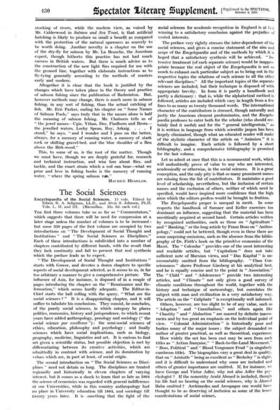Salmon Fishing
Where the Spring Salmon Run. By Patrick R. Chalmers, (Philip Allan. 12s. 6d.) The Lonsdale Library. Vol. X. Salmon Fishing. By Erio Taverner, with contributions by G. M. L. La Brendle, Erie Parker, W..1. M. Menzies, J. A. Rennie, A. H. E. Wood, Wynd.; ham Forbes, Thomas Rook and Alban Bacon. (Seeley Service. 25s.)
HERE are two books on fishing,. both on one branch of the art, both excellent of their kind, both adorned with photo- graphs which stir the fisherman's blood—yet how different one from the other ! While the Lonsdale Library book is necessarily encyclopaedic, and Mr. Chalmers would only claim to be episodic, or (as he might dislike the word) descriptive, the mere fact that two such books should appear at the same time shows, not only the development of modern fishing literature, but its specialization. Salmon books there have been in plenty, and this by Mr. Chalmers will be accepted at once by fishermen as one of the most delightful.
Though he does not claim to instruct—he professes to write " with little knowledge and a great love "—most of them will learn something from him, as they will surely enjoy his charming prose. But the Lonsdale Library book marks an epoch. Its mere size, as compared with the Badminton book (which also included trout, sea trout and grayling), shows how far we have progressed since 1885, both in know- ledge of the natural history of the salmon and in the art of fishing for him. Then, Badminton contains no mention of scales—the whole science of scale-reading has been developed since then. And the chapter by Mr. Menzies of the Scottish Fishery Board, an acknowledged authority, gives us all that has been learned about it, or as much as possible in the space allowed. Of course, too, the writers in the Badminton book knew nothing of the greased-line, on which the inventor of this method, Mr. A. H. E. Wood, contributes a most interesting chapter, and on which Major J. W. Hills comments in a short note. The fact that Mr. Taverner, who gives us eight chapters on fly-fishing, thinks it necessary to call it " The practice of fishing with the Sunk Fly "—as opposed, of course, to Mr. Wood's new method which he calls a " revolution," of fishing with a greased line and the fly just submerged—marks the importance of the new method. It is not too much to say that the con- sciousness of the coming of this new method, " out of which the technique of the future will be built," overshadows these eight chapters ; and Major Hills, a veteran salmon fisher in the old style, finds in it " a deeper appeal to your intellect and emotion." Another suggestive fact is that, while Badminton contains thirty pages on salmon (and trout)
culture, the subject is only just mentioned in the Lonsdale book. The Badminton editor was, of course, under the influence of Frank Buckland's fervid enthusiasm (which waned somewhat with fuller experience) for the artificial stocking of rivers, while the modem view, as voiced by Mr. Calderwood in Salnion and Sea Trout, is that artificial hatching is likely to produce so small a benefit as compared with the protection of the natural spawners as scarcely to be worth doing. Another novelty is a chapter on the use of the dry-fly for salmon by Mr. La Branche, the American expert, though hitherto this practice has not had much success in British waters. But there is much advice as to the construction of the new light flies required for use with the greased line, together with elaborate instructions as to fly-tying generally according to the methods of masters early and modern.
Altogether it is clear that the book is justified by the changes which have taken place in the theory and practice of salmon fishing since the publication of Badminton. But, however methods may change, there is much more in salmon fishing, in any sort of fishing, than the actual catching of fish. Mr. Eric Parker, ending his chapter on " Some Names of Salmon Pools," says truly that in the names alone is half the meaning of salmon fishing. Mr. Chalmers tells us of " the jewel names—Ugie, Ythan, Dee, Findhom and Brora- the jewelled waters, Lochy Spean, Roy, Arkaig. . . . I stand," he says, and I wonder and I pass on the better, always, for a memory of running water, a memory of stark rock or shifting gravel-bed, and the blue shoulder of a Ben above the Birk-wood."
This, to some of us, is the root of the matter. Though we must have, though we are deeply grateful for, research and technical instruction, and wise lore about flies, and tackle, and the exact strain which a rod can bear—what we prize and love in fishing books is the memory of running water, where the spring salmon run."
MAURICE HEADLA31.











































 Previous page
Previous page